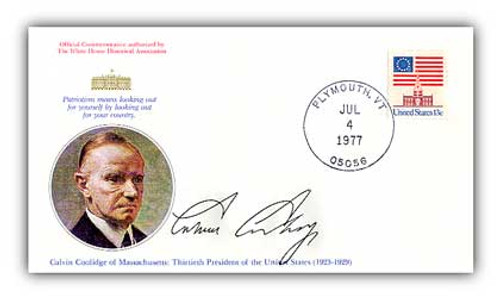
# 96136 - 1977 Martin Van Buren Commemorative Cover
Own a Limited-Edition Van Buren Commemorative Cover
This neat Fleetwood cover was produced in cooperation with the White House Historical Association to honor President Martin Van Buren. It was canceled on Van Buren's 195th birthday in his hometown of Kinderhook, New York. This cover will make a great addition to your US history or Presidents collection.
Happy Birthday Martin Van BurenÂ
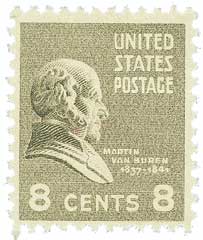
Martin Van Buren was born on December 5, 1782, in Kinderhook, New York. He was the first President born an American citizen (all of his predecessors were born before the American Revolution).
As a child, Van Buren spent time in his father’s tavern, a popular stop for politicians traveling between Albany and New York City. His interest in politics sparked at this early age. At the age of 17, he had his first taste of political life, attending a party convention where he helped attain John Van Ness’ congressional nomination.
Since Van Buren’s family could not afford to pay for college, he took a job as a law office clerk, where he began studying law on his own. In 1802, he completed his study under William Peter Van Ness. He was admitted to the bar the following year, at the age of 20.
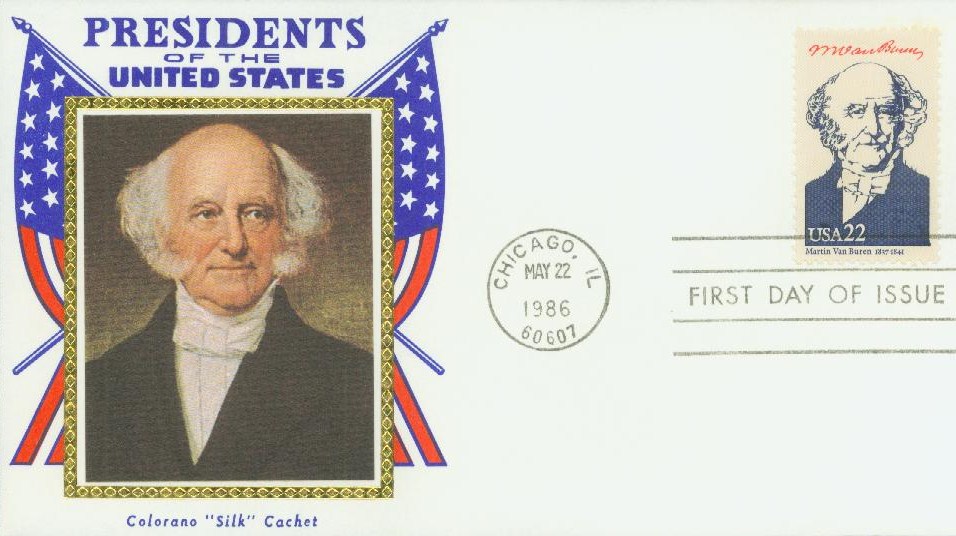
A diligent lawyer, Van Buren established a successful practice that enabled him to focus on his political career. In 1812, as a member of the New York State Senate, Van Buren supported the war and formulated a classification act for getting volunteers. His influence with local government helped pass a bill that used state bonds to fund construction on the Erie Canal. Van Buren created New York’s first political machine in 1817 – the Bucktails – led by a group known as the Albany Regency. Van Buren’s skill in forming and managing the party earned him the nickname “Little Wizard.â€
Van Buren was elected to the United States Senate in 1821. At first, he supported internal improvements like road repairs and canal construction. But the following year he voted against them, claiming “tariffs for revenue only.†In the presidential election of 1824, Van Buren was nominated as a vice presidential candidate with William H. Crawford as his presidential running mate. However, John Quincy Adams won the nomination and then the controversial election.
Following the election, Van Buren worked to unite Crawford and Andrew Jackson. After Van Buren’s 1827 re-election to the Senate, he became one of Jackson’s campaign managers and successfully persuaded Crawford supporters to back Jackson. Part of Van Buren’s plan included reorganizing the old Republican Party, with Jackson as its leader. Van Buren was influential in formulating the grassroots style of politics that is still practiced.
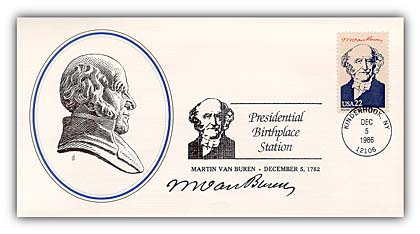
Van Buren was elected governor of New York in 1828, but resigned the following year when Jackson appointed him secretary of state. Van Buren handled his position with poise and integrity. He sided with Jackson on the spoils system as well as the Calhoun feud over secession. Van Buren helped settle diplomatic issues with France and was influential in opening trade with the British West Indies.
Mounting tensions between Jackson and Calhoun became a serious issue as Van Buren realized the Cabinet was backing Calhoun more than Jackson. To resolve the situation, Van Buren offered that he and Secretary of War Eaton resign, causing the remaining Cabinet members to resign. After Jackson appointed a new Cabinet, he rewarded Van Buren with the position of minister to Great Britain. Van Buren reached London in September 1831, but received word the following February that Calhoun (who was president of the Senate) cast the deciding vote against Van Buren, revoking his position.
After Jackson and Calhoun parted ways over the South Carolina secession threat, Van Buren was Jackson’s first choice for Vice President. Van Buren returned to the U.S. in July 1832, just after the very first Democratic National Convention which nominated him as Jackson’s Vice President. In their bid for the office, Van Buren showed strong support for an expanded naval system and rejection of the U.S. Bank and nullification, which was a state challenge to Federal authority. The pair won by a landslide.
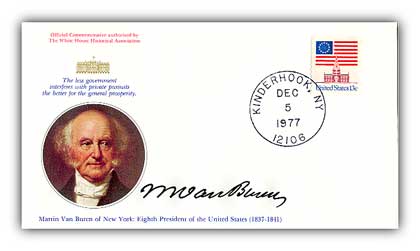
When Jackson’s term in office neared its end, he was determined to get Van Buren elected and continue his legacy. Van Buren was pitted against three Whig candidates. William Henry Harrison sought to win over the Western voters, while Daniel Webster was popular in New England, and Hugh Lawson had the support of the South. Unanimously nominated by the 1835 Democratic National Convention, Van Buren spoke frankly against slavery and the United States Bank, while calling for stricter laws in regard to abolitionist literature. Van Buren’s election to the presidency was a victory not only for himself, but for Jackson and the Democratic Party.
Upon his succession to the presidency, Van Buren declared his plan to “follow in the footsteps of his illustrious predecessor,†keeping all but one of Jackson’s Cabinet members. However, Van Buren was ill equipped to deal with the Panic of 1837 and spent the majority of his term trying to resolve it. He supported lower tariffs and free trade and instituted a system of bonds for the national debt. Despite his attempts, his party was so split that the Independent Treasury proposal of 1837 was not passed until 1840. Additionally, many states could not pay their state bonds, which led to numerous complaints from London. This led to negative coverage of America in the British press.
Van Buren faced more foreign difficulties during the Caroline Affair in December 1837 in which Canadian rebels began using New York bases to attack the Canadian government. The Canadian government then crossed the border to the U.S., burning the Caroline, which the rebels had received from American sympathizers. The death of one American led to a flood of anti-British feeling. After Van Buren closed down rebel bases, he tried to institute neutrality laws, but the majority of Americans sided with the rebels.
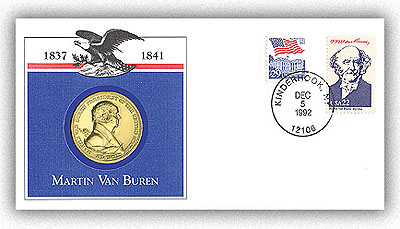
Van Buren’s foreign policy woes continued as he attempted to settle financial disputes with Mexico diplomatically rather than by force. Van Buren refused to enter into a war, forcing him to make some unpopular decisions. In the Amistad case, he sided with the Spanish government, which demanded the return of kidnapped slaves. He also presided over the Trail of Tears, the removal of the Cherokee tribe from Georgia, Tennessee, Alabama, and South Carolina to the Oklahoma territory in 1838.
Van Buren suffered endless ridicule from the opposing Whig party throughout his term in office. They nicknamed him “Martin Van Ruin†and attacked him in part for his high-class style, despite his humble upbringing. A partial economic recovery of 1839 was only temporary, as another crisis arose later the same year. In spite of all the obstacles he faced, the Democratic Party unanimously nominated him again for the presidency in 1840. Despite receiving 40,000 more votes than he had in the 1836 election, national anti-Democratic feelings led to the election of Whig candidate William Henry Harrison.
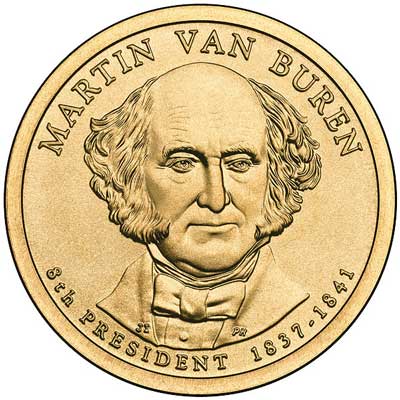
After leaving the White House, Van Buren returned to his Kinderhook home, Lindenwald, and immediately began planning his reelection campaign. Although he had the majority of the votes at the Democratic convention, he did not have a two-thirds majority needed and the nomination was instead given to James K. Polk. In the 1848 election, two minor parties – the Barnburners and Free Soilers – nominated him, but he failed to receive any electoral votes.
Following the 1860 election, Van Buren retired from politics. He died from bronchial asthma and heart failure in his home on July 24, 1862. Although his term in office was plagued with economic and foreign struggles, many historians consider Van Buren fundamental in the development of America’s political system.
Own a Limited-Edition Van Buren Commemorative Cover
This neat Fleetwood cover was produced in cooperation with the White House Historical Association to honor President Martin Van Buren. It was canceled on Van Buren's 195th birthday in his hometown of Kinderhook, New York. This cover will make a great addition to your US history or Presidents collection.
Happy Birthday Martin Van BurenÂ

Martin Van Buren was born on December 5, 1782, in Kinderhook, New York. He was the first President born an American citizen (all of his predecessors were born before the American Revolution).
As a child, Van Buren spent time in his father’s tavern, a popular stop for politicians traveling between Albany and New York City. His interest in politics sparked at this early age. At the age of 17, he had his first taste of political life, attending a party convention where he helped attain John Van Ness’ congressional nomination.
Since Van Buren’s family could not afford to pay for college, he took a job as a law office clerk, where he began studying law on his own. In 1802, he completed his study under William Peter Van Ness. He was admitted to the bar the following year, at the age of 20.

A diligent lawyer, Van Buren established a successful practice that enabled him to focus on his political career. In 1812, as a member of the New York State Senate, Van Buren supported the war and formulated a classification act for getting volunteers. His influence with local government helped pass a bill that used state bonds to fund construction on the Erie Canal. Van Buren created New York’s first political machine in 1817 – the Bucktails – led by a group known as the Albany Regency. Van Buren’s skill in forming and managing the party earned him the nickname “Little Wizard.â€
Van Buren was elected to the United States Senate in 1821. At first, he supported internal improvements like road repairs and canal construction. But the following year he voted against them, claiming “tariffs for revenue only.†In the presidential election of 1824, Van Buren was nominated as a vice presidential candidate with William H. Crawford as his presidential running mate. However, John Quincy Adams won the nomination and then the controversial election.
Following the election, Van Buren worked to unite Crawford and Andrew Jackson. After Van Buren’s 1827 re-election to the Senate, he became one of Jackson’s campaign managers and successfully persuaded Crawford supporters to back Jackson. Part of Van Buren’s plan included reorganizing the old Republican Party, with Jackson as its leader. Van Buren was influential in formulating the grassroots style of politics that is still practiced.

Van Buren was elected governor of New York in 1828, but resigned the following year when Jackson appointed him secretary of state. Van Buren handled his position with poise and integrity. He sided with Jackson on the spoils system as well as the Calhoun feud over secession. Van Buren helped settle diplomatic issues with France and was influential in opening trade with the British West Indies.
Mounting tensions between Jackson and Calhoun became a serious issue as Van Buren realized the Cabinet was backing Calhoun more than Jackson. To resolve the situation, Van Buren offered that he and Secretary of War Eaton resign, causing the remaining Cabinet members to resign. After Jackson appointed a new Cabinet, he rewarded Van Buren with the position of minister to Great Britain. Van Buren reached London in September 1831, but received word the following February that Calhoun (who was president of the Senate) cast the deciding vote against Van Buren, revoking his position.
After Jackson and Calhoun parted ways over the South Carolina secession threat, Van Buren was Jackson’s first choice for Vice President. Van Buren returned to the U.S. in July 1832, just after the very first Democratic National Convention which nominated him as Jackson’s Vice President. In their bid for the office, Van Buren showed strong support for an expanded naval system and rejection of the U.S. Bank and nullification, which was a state challenge to Federal authority. The pair won by a landslide.

When Jackson’s term in office neared its end, he was determined to get Van Buren elected and continue his legacy. Van Buren was pitted against three Whig candidates. William Henry Harrison sought to win over the Western voters, while Daniel Webster was popular in New England, and Hugh Lawson had the support of the South. Unanimously nominated by the 1835 Democratic National Convention, Van Buren spoke frankly against slavery and the United States Bank, while calling for stricter laws in regard to abolitionist literature. Van Buren’s election to the presidency was a victory not only for himself, but for Jackson and the Democratic Party.
Upon his succession to the presidency, Van Buren declared his plan to “follow in the footsteps of his illustrious predecessor,†keeping all but one of Jackson’s Cabinet members. However, Van Buren was ill equipped to deal with the Panic of 1837 and spent the majority of his term trying to resolve it. He supported lower tariffs and free trade and instituted a system of bonds for the national debt. Despite his attempts, his party was so split that the Independent Treasury proposal of 1837 was not passed until 1840. Additionally, many states could not pay their state bonds, which led to numerous complaints from London. This led to negative coverage of America in the British press.
Van Buren faced more foreign difficulties during the Caroline Affair in December 1837 in which Canadian rebels began using New York bases to attack the Canadian government. The Canadian government then crossed the border to the U.S., burning the Caroline, which the rebels had received from American sympathizers. The death of one American led to a flood of anti-British feeling. After Van Buren closed down rebel bases, he tried to institute neutrality laws, but the majority of Americans sided with the rebels.

Van Buren’s foreign policy woes continued as he attempted to settle financial disputes with Mexico diplomatically rather than by force. Van Buren refused to enter into a war, forcing him to make some unpopular decisions. In the Amistad case, he sided with the Spanish government, which demanded the return of kidnapped slaves. He also presided over the Trail of Tears, the removal of the Cherokee tribe from Georgia, Tennessee, Alabama, and South Carolina to the Oklahoma territory in 1838.
Van Buren suffered endless ridicule from the opposing Whig party throughout his term in office. They nicknamed him “Martin Van Ruin†and attacked him in part for his high-class style, despite his humble upbringing. A partial economic recovery of 1839 was only temporary, as another crisis arose later the same year. In spite of all the obstacles he faced, the Democratic Party unanimously nominated him again for the presidency in 1840. Despite receiving 40,000 more votes than he had in the 1836 election, national anti-Democratic feelings led to the election of Whig candidate William Henry Harrison.

After leaving the White House, Van Buren returned to his Kinderhook home, Lindenwald, and immediately began planning his reelection campaign. Although he had the majority of the votes at the Democratic convention, he did not have a two-thirds majority needed and the nomination was instead given to James K. Polk. In the 1848 election, two minor parties – the Barnburners and Free Soilers – nominated him, but he failed to receive any electoral votes.
Following the 1860 election, Van Buren retired from politics. He died from bronchial asthma and heart failure in his home on July 24, 1862. Although his term in office was plagued with economic and foreign struggles, many historians consider Van Buren fundamental in the development of America’s political system.




